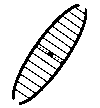 |
|
Desaru
ship |
19 July 2003
|
|||
| Last modified: 19 July 2003 |
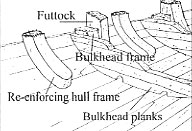 |
 Profiles of six bulkhead frames |
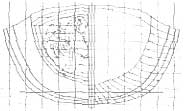 Possible ship profile, projected from curvature of lower bulkhead frames |
 Longitudinal partitions between bulkheads |
 Ceiling boards |
The only remains of the ship were from the lower hull, including parts of transverse bulkheads and associated frames, and the mast step.
Edge-joined hull planks were nailed to transverse frames, to which bulkhead planks were also afixed. The distance between the main transverse bulkheads averaged 1.55 metres. Hull and bulkhead planks were six centimetres thick, the frames varying between nine and nineteen centimetres. The bulkhead frames were made from logs split longitudinally without much additional trimming - ie, one side was convex while the cut side was flat and used to attach the bulkhead planks. These main frames ended about ninety centimetres above the keel, flat with the surrounding seabed. This height coincides with the two tiers of storage jars (49 and 41 centimetres high) stored inside the hull; the seabed was about level with the rim of the uppermost jar.
The bulkhead frames were cut in one length, except the frames at bulkheads 18 & 19, which had scarfed joints above the keel. The end of the frames were joined to a futtock which once continued up the ship's side. (A futtock is a curved rib which is not a floor frame.) The lower end of additional hull-reinforcing ribs was seen between bulkheads. These ribs started at abut the same level where the futtocks were installed. Probably the ribs, like the futtocks, once reached all the way to the deck.
Between bulkheads 10 & 11, an extra frame was inserted, adding support for the main mast. Yet another frame was inserted between bulkheads 16-17 and 18-19, and this one is believed to have supported a foremast.
The length of the ship's remaining hull was around thirty metres, and the beam slightly wider than six metres. Allowing for a bow and stern section, extending past the present remains on the seabed, the ship could have been around thirty-four metres long at deck level. By plotting the bilge keel and projecting the curvature of existing bulkhead frames to a predicted deck level, it is estimated that the ship was about eight metres wide. This is an unusually low beam-to-length aspect ratio (ie the ship was long and narrow).
Longitudinal partitions between bulkheads divided some of the cargo holds into smaller compartments. These additional divisions were probably never any higher than eighty centimetres, as the frames guiding the planks terminated at this height. These vertical guide frames had grooves into which each plank was loosely inserted, allowing its height to be adjusted as required.
Bulkhead planks were originally secured by square nails to their respective frames. Hull planks were similarly nailed to the bulkhead frames and additional hull reinforcing ribs. All the nails had corroded, leaving only oxide stains around square holes. During excavation, structural members were held in place only by the ceramics and the surrounding compacted mud.
Although the use of nails would be an expected system of securing planks, the total lack of stronger penetrating bolts to secure highly-stressed structural members was a surprise. Despite heavy transverse and longitudinal loads throughout the ship during sailing, no bolts (or holes, or oxide stains) were found on the hull, between overlapping bulkhead frames and futtocks, or on the mast-supporting structure which is subjected to enormous loads in all directions.
Repairs to the hull were immediately noticeable. Extra planks, two and a half centimetres thick, had been added both inside and outside the hull. The external planks were nailed directly to the hull without any caulking material in between. The internal planks, fitted in patches wherever needed, were cut in shorter lengths and fitted between the bulkhead frames.
The use of sacrificial external planks, which could be replaced after worm attack, had been common practice in China for centuries(1) - as it had in Europe, but by the 18th century many European ships were fitted with copper sheathing. The Diana, built to British specifications in Chittagong in 1812, was sheathed with copper(2).
Another unusual feature of the Desaru ship was its internal cargo deck: ceiling boards carried the load of the cargo. Such cargo decks were normally supported, directly or indirectly, by a bulkhead frame such that the weight of the cargo was distributed along its full length. In this case, horizontal transverse frames, placed between the bulkhead frames, supported the boards. To allow for the curvature of the hull, a few wedges were placed between the hull planks and the supporting frames, which would have been dangerous in heavy seas.
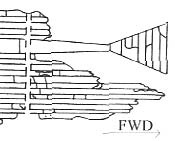 Bow of Shinan wreck |
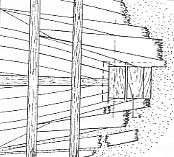 Bow of Desaru wreck |
The keel, which was completely accessible only at the stern, had no visible bolts or nails securing it to the transverse frames. Projections of bulkhead profiles and their respective heights indicate that the ship had a slightly curved keel. Aft of bulkhead 6, the inner part of the keel bent upwards, ending at the stern even with the seabed. The lower part of the keel continued to the stern in a slight curve, and the keel was one metre deep at the stern. Forward of bulkhead 18, the keel again bent upwards in a curve, ending level with the seabed.
The depth of the keel could not be measured, but it was generally twenty-two centimetres wide, measured from the inside of the hull. It had a recess on each side of about seven centimetres into which the innermost hull planks were fitted. Its maximum width was thus thirty-six centimetres. Forward of bulkhead 18, the keel tapered towards the bow where it was only eleven centimetres wide. The forward end of the keel terminated abruptly in planks secured in a perpendicular direction, each sixty centimetres long. These transverse planks, recessed each side to support adjoining hull planks, formed the lower end of a square bow.
Other shipwrecks found in the region provide interesting comparisons. The Shinan wreck, a Chinese ship found in Korea, dated by a cargo tag to 1323, shows similar planks attached to a tapered keel(3). While the Shinan ship's bow planks form a triangle, flaring out from the keel, another Chinese wreck recently excavated in Vietnam and dated to the early 16th century has similar planks making a trapezoidal section(4). On the Desaru ship, bow planks were placed perpendicular to the keel forming a rectangle.
The bottom of the Desaru ship is rather flat, except in the stern where the hull retracts into a 'V' shape, ending in a deep stern keel. On comparing the ship's profile in the stern with that of the bow, where it is gently curved, it is apparent that the designer wanted a broad and flat bow section, with full buoyancy, allowing for smooth sailing in choppy seas. Although no rudder or rudder attachments were found in or around the stern keel, the straight cut of the surviving timbers indicates the end of the vessel. The foremost part of the bow however had mostly disappeared, and could have extended two or three metres beyond its present measurable length.
Despite the ship's length, only one lower end of a mast foot and supporting structure could be found. This was situated amidships, between bulkheads 10 & 11. In this compartment, there were two additional transverse frames, both directly supporting the mast. The mainmast foot was about one meter high, ending level with the seabed. Despite special efforts to locate another mast, it is certain that no such additional mast remained. However, between bulkheads 16 & 17 there were two additional intermediate frames inserted, similar to those supporting the main mast. As this was the only other compartment with extra bulkhead frames, it is possible that a foremast once stood here. There were no traces whatsoever of a third mast, which would have been expected on a ship of this size. As the mapping and recording proceeded, it was decided to retrieve the remaining mast foot and associated structure. Its unusual features and lack of securing bolts were thought to be of interest, and should be preserved and displayed at a future maritime archaeology museum.
 The mast foot was supported by two additional bulkhead frames inserted for this purpose. |
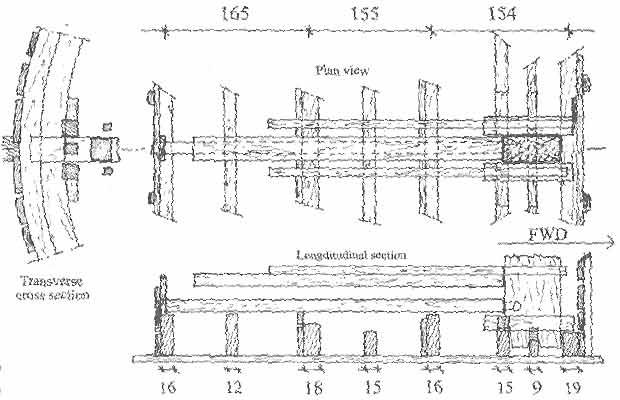 Three longitudinal wooden beams distributed the load from the base of the mast towards the stern; there it was further distributed by centrally located partitions. Measurements in cm. |
Samples of the ship's timber collected during the surface investigation showed that the ships hull was made from Cedus species (cedar) and the transverse bulkheads from Pinus species (pine)(5). Other samples taken during the excavation were more difficult to identify, due to decomposition. Examination was limited to surface and cross sections, but indicate that the mast was made from Garcinia species (kandis), a tree growing throughout the tropics. Similar examination of a longitudinal mast support indicates that it was made from Dialitum species (keranji), a species growing throughout lowland Malaysia, Thailand and Indo-China(6). Chinese shipbuilders are reported to have imported some timber, which probably explains the intriguing mixture of tropical and temperate climate wood used in the Desaru construction(7). The utilisation of a rather rigid tropical wood for the mast is particularly interesting. Traditionally, the Chinese preferred a softer and more flexible timber for masts, such as pine or cedar, then plentiful in Fujian province(8).
The ship's remains do not reveal the reasons for loss. A small patch of burnt wood was seen in bulkhead frame number ten, next to the mast, but did not appear large enough to suggest that the ship was lost due to fire, although this was a common reason for shipwreck.
All but one of the hull planks were found in place, suggesting that the hull was intact before sinking; the exceptional bow plank is quite likely to have broken when the ship hit the seabed rather than on collision with a reef or another ship.
Pirates could have attacked the Desaru ship, killed her captain, captured passengers and crew, taken the most precious cargo, and set fire to the ship before selling the captured as slaves. If this happened, the pirates would have been likely to take the ship's cannons, valuable commodities at the time. Piracy was virtually uncontrolled during the first half of the 19th century. Writing in the late 1830's, Newbold indicated that pirate activities around the Malay peninsula were seasonal and determined by the wind conditions. From April to May, pirates would focus on the east coast; from June to September the brunt of their depredations fell on Johor and nearby islands. One pirate chief boasted that he had killed twenty-seven captains of European ships with his own hands. Piracy was curbed in 1837 when Admiralty jurisdiction granted prosecuting authority to the Straits Settlements; until then, all cases had to be referred to Calcutta. Around this time, Singapore started to supply ships with anti-pirate cannon, similar to the one found on the Desaru ship.
| Desaru ship overview | Maritime Asia homepage | Next: the ship's cargo |